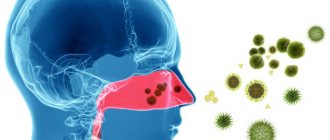Discomfortable sensations that occur during the act of swallowing indicate the presence of malfunctions in the functioning of individual organs and systems. A lump in the throat after eating can be accompanied by burning, pressure, pain and suffocation. Pathological symptoms have a destructive effect on the patient’s well-being and quality of life, which often leads to the development of depressive conditions.
Pathological symptoms have a destructive effect on the patient’s well-being and quality of life, which often leads to the development of depressive conditions.
The sensation of a foreign body in the respiratory tract is a consequence of the development of mental or somatic diseases. Concomitant clinical manifestations make it possible to accurately determine the type of disease and, accordingly, choose the optimal way to solve the problem. Ignoring a symptom entails dire consequences, in particular, with the development of infectious diseases, tissue abscess or even blood poisoning cannot be ruled out.
Lump in throat - what is it?
Patients may interpret the manifestation of discomfort in the respiratory tract differently. Some complain of painful swallowing of saliva, which appears immediately after eating, while others complain of burning, stinging and soreness in the throat area. Some patients claim that a foreign body in the throat prevents them from breathing normally, which leads to panic attacks.
Along with discomfort in the larynx, patients often complain of a number of specific accompanying manifestations, namely:
nausea; stomach pain; fever; chronic fatigue; dizziness; moderate chest pain; apathy; panic attacks.
Based on the complaints described above, it is almost impossible to make an accurate diagnosis. The disease can be determined only after undergoing hardware diagnostics, during which the doctor must perform fibrogastroscopy, evaluate the results of a biochemical blood test and bacterial culture from the patient’s throat.
Diagnostic features
If you do not know what reasons could have caused the appearance of a lump in the throat and cough symptoms, then you should immediately consult a doctor. During your visit, the doctor will conduct a full diagnosis of the entire body, identify why these symptoms appeared, and prescribe effective treatment.
Diagnosis begins with a history and personal examination
In order to identify the causes of a coma along with a cough, the following diagnostic methods are usually used:
at the initial stage, the doctor asks the patient about his general condition and performs an examination; a general examination of blood and urine is performed; if necessary, a highly specialized examination of the material can be done; the doctor must carefully examine the oral cavity, palatine tonsils, and the area of the root of the tongue; this study is called oropharyngoscopy; thorough examination of the cervical lymph nodes and thyroid gland; sometimes indirect laryngoscopy is performed; a CT or MRI of the spine, especially the neck area, may be prescribed; X-ray examination of the neck;
To make a diagnosis, blood and urine tests are taken
if the need arises, an ultrasound of the thyroid gland can be performed; conducting a test to help determine the level of hormones in the thyroid gland.
Causes
Why does a lump appear in the throat after eating? The sensation of a foreign body in the airways is a typical manifestation of more than 30 different diseases. Due to the fact that discomfort appears mainly immediately after eating, the doctor first excludes or confirms the presence of gastroenterological pathologies.
In some cases, pharyngeal obstruction is caused by spasm of smooth muscles, tumor formation and psychogenic disorders. If a patient claims that he has a lump in his throat after eating, this may indicate the development of the following diseases:
gastroesophageal reflux; hiatal hernia; dysphagia; myasthenia gravis; aortic aneurysm; esophageal diverticulum; infectious inflammation; "hysterical lump"
Throat stenosis causes hypoventilation of the lungs, which can cause the patient to fall into a coma.
Many patients are in no hurry to contact specialists because they are afraid to discover a tumor or other serious disease that cannot be treated. It should be taken into account that in 93% of cases, timely completion of therapy reduces the risk of developing severe pathologies by 3-4 times. To determine what exactly caused the discomfort in the pharynx, it is worth considering common diseases and their accompanying clinical manifestations.
Treatment for difficulty swallowing
The feeling of a plug in the throat can bother a person for years and last for a long time in a mild form.
However, this symptom cannot be ignored, since quite serious pathologies may be behind it. If you feel like there is food in your throat, you need to consult a specialist and undergo a series of examinations.
Since the underlying disease must be identified, several specific examination methods must be performed. These include a patient interview, examination of the throat by an ENT doctor, endoscopy, radiography with a contrast agent, histology, bacteriological examination in the presence of an inflammatory process. If necessary, consult a neurologist and psychotherapist.
Treatment depends entirely on the diagnosis and is aimed primarily at eliminating the root cause.
For example, if dysphagia was caused by tumor formations of the esophagus, then surgical removal of the tumor is performed.
It is necessary to exclude fried, fatty, salty, spicy foods. You can eat your last meal no later than 2-3 hours before bedtime. Additionally, the doctor may prescribe sedatives, vitamin complexes, and mild painkillers.
Dysphagia
Dysphagia is a swallowing disorder that interferes with the normal passage of food and liquid through the esophagus. Pathology can appear as a result of septic inflammation of the trachea, esophagus, larynx and oropharyngeal mucosa. Most often, dysphagia develops against the background of diffuse spasm of the esophagus or the formation of benign and malignant tumors.
Dysphagia is accompanied by specific manifestations, which include:
periodic cough; difficulty swallowing saliva; pain when food passes through the esophagus; penetration of food particles into the trachea or larynx.
In most cases, patients have difficulty eating only solid foods. Therefore, at the time of undergoing therapy, they adhere to a diet that consists of eating only liquid food.
Gastroesophageal reflux
Gastroesophageal (gastroesophageal) reflux is the reflux of duodenal contents into the airways through the esophageal sphincter. Aggressive acids contained in gastric juice penetrate the mucous epithelium of the respiratory tract, which leads to a burn. In this regard, patients complain of a burning sensation, a sensation of a lump in the throat, dry mucous membranes and pain when swallowing saliva.
Reflux may appear immediately after eating or the patient taking a horizontal position. Passive reflux of gastric masses into the oropharynx provokes the appearance of a sour taste in the mouth. The cause of pathological reflux is:
increased intra-abdominal pressure; overweight; decreased tone of the esophageal sphincter; a sharp decrease in esophageal clearance; increased acidity of gastric juice.
Irrational use of medications leads to a decrease in smooth muscle tone, which entails the development of pathological reflux and discomfort in the pharynx.
The development of gastroesophageal reflux is indicated by heartburn, hiccups, frequent regurgitation of food, sensation of a foreign body in the larynx, and moderate pain in the stomach. Untimely elimination of the problem entails ulcerative-erosive damage to the mucous membranes of the airways. In addition, pathological processes in the gastrointestinal tract lead to metaplasia, i.e. replacement of squamous epithelium with columnar epithelium, which greatly increases the risk of developing cancer.
Hiatal hernia
Hiatal hernia is a sluggish pathology characterized by an expansion of the diameter of the esophageal opening, in which there is a displacement of part of the esophagus into the chest cavity. In the absence of disturbances, the abdominal part of the gastrointestinal tract is located in the abdominal cavity. The development of a hiatal hernia in patients is indicated by the following clinical manifestations:
hiccups; heartburn; hoarseness of voice; chest pain; burning in the throat; sensation of a foreign body in the larynx; glossalgia (painful tongue); dysphagia (difficulty moving food through the esophagus).
A lump in the throat in pregnant women often occurs as a result of increased intra-abdominal pressure caused by the development of the uterus.
While eating, food can get stuck in the esophagus due to weakening of the musculo-ligamentous apparatus of the gastrointestinal tract. Relaxation of the muscles leads to expansion of the opening of the esophageal canal, as a result of which the formation of a hernial orifice is observed.
When to Seek Help from a Doctor
If you are coughing and feel like there is a lump in your throat, but your health returns to normal within 24 hours, there is no reason to worry. It makes sense to consult a doctor when, along with a lump in the throat, there are symptoms such as weakness and nausea, fever, dizziness, pain in the abdomen, chest and/or throat, upset bowel movements, or if you have been feeling sick for a long time and severely , then vomiting, after vomiting there is a feeling of something extra in the throat, and this feeling does not go away.
Patients who complain of a feeling of fullness in the esophagus are usually asked to undergo an examination, including:
1 blood, urine and stool test;
6 Ultrasound of the thyroid gland and abdominal organs.
The primary examination of the patient is carried out by a therapist, who also decides to involve specialized specialists in the examination.
Myasthenia gravis
Myasthenia gravis or false bulbar palsy is a pathology characterized by rapid fatigue of muscle tissue. Autoimmune disorders play a key role in the development of neuromuscular diseases, which lead to damage to the masticatory muscles and disruption of the act of swallowing. Provocateurs of pathological processes are:
frequent stress; emotional stress; chronic pathologies; decreased immunity; irrational use of immunocorrectors.
A sensation of a lump in the throat associated with rapid muscle fatigue is most often diagnosed in adolescent patients.
Against the background of intense physical activity, an increase in fatigue is observed in absolutely all muscle groups. Eating becomes a real problem for patients, since when swallowing food, the muscles of the pharynx practically do not contract. Each meal is accompanied by a change in voice and dysarthria. Constant choking increases the risk of aspiration of fluid and the development of obstruction in the respiratory system.
Aortic aneurysm
Pathological expansion of the aorta in the neck area leads to compression of the muscles of the pharynx, resulting in a sensation of a lump in the larynx. Aortic aneurysm occurs as a result of dystrophic changes in the structure of blood vessels or inflammatory reactions. At the same time, patients report that they feel like there is a lump in the Adam’s apple area, which makes breathing and swallowing difficult.
Most often, an aortic aneurysm occurs against the background of the development of syphilis, infectious pathologies, atherosclerosis and diabetes mellitus. The dilated part of the vessels creates excess pressure on the muscles of the pharynx, trachea and inferior laryngeal nerve. The development of the disease is indicated by:
dry cough; discomfort when swallowing; sensation of a foreign body in the throat; hoarseness of voice; aching sore throat; attacks of suffocation; hemoptysis.
Important! A lump in the throat that occurs as a result of dilatation of the aorta can provoke spasm of the pharyngeal muscles and asphyxia.
Food stopper
Even on the surface of completely normal tonsils there are depressions called lacunae. Traffic jams, including food ones, can form in these recesses. They do not pose a health hazard, since the tonsils have the ability to self-cleanse. There is no specific treatment.
But due to the unpleasant odor from food lingering in the throat and on the tonsils, which, in fact, are plugs, the lacunae are washed by an ENT doctor. Vacuum suction of the contents of lacunae is also used.
A person who has such plugs is not recommended to remove them themselves, as there is a risk of worsening the situation - food will go deeper into the lacuna and cause complications.
Traffic jams can form with frequent pharyngitis and tonsillitis. In such a situation, it will be useful to rinse your mouth and throat after eating; this will help maintain oral hygiene at the proper level and wash away food debris from the surface of the tonsils.
Do you still think that it is impossible to get rid of constant colds, FLU and THROAT DISEASES!?
Judging by the fact that you are reading this article, you know firsthand what it is:
- severe pain in the throat even when swallowing saliva...
- constant feeling of a lump in the throat...
- chills and weakness in the body...
- "breaking" of bones at the slightest movement...
- complete loss of appetite and strength...
- constant nasal congestion and coughing up snot...
Now answer the question: are you satisfied with this? Can ALL THESE SYMPTOMS be tolerated? How much time have you already wasted on ineffective treatment? After all, sooner or later the SITUATION WILL GET WORSE. And things could end badly...
That's right - it's time to start ending this problem! Do you agree? That is why we decided to publish an exclusive method by Elena Malysheva, in which she revealed the secret of strengthening the immune system in children and adults, and also talked about methods of preventing COLD DISEASES.
This condition can be based on two types of causes: mental and somatic. Methods for eliminating such an unpleasant feeling after eating, like a lump in the throat, directly depend on the cause that caused it.
Esophageal diverticulum
Esophageal diverticulum is a protrusion of the layers of the esophageal wall caused by deformation of the esophagus. Pharyngeal-esophageal diverticula occur against the background of inflammatory reactions in the gastrointestinal tract or decreased tone of the muscular layer of the esophagus. As a rule, a pathology in which a lump may “stand” in the throat area is preceded by gastroesophageal reflux, tuberculosis of the lymph nodes and esophageal candidomycosis.
Symptoms of esophageal diverticula are determined by their location. Pharyngeal-esophageal diverticula are most often accompanied by:
dysphagia; sensation of a lump in the throat; painful swallowing; burning in the oropharynx; hypersalivation (salivation); putrid odor from the mouth.
Delayed elimination of pharyngoesophageal diverticula entails the development of phlegmon of the neck.
The disease is treated with medications in a hospital setting under the supervision of a gastroenterologist. During therapy, patients should refrain from eating solid foods in favor of liquid cereals, cream soups, etc. Surgical treatment of pathology is carried out only in the presence of extensive defects, which are accompanied by perforation of the walls of the esophagus, dysphagia and internal bleeding.
Treatment
As a rule, the choice of methods and methods of treatment is directly related to the cause of the unpleasant condition.
Medications
There is a fairly wide range of drugs that can help get rid of an unpleasant symptom. Note! It is recommended to take certain medications only after consulting a doctor and establishing the cause.
So, if there are problems with the gastrointestinal tract, the patient may be prescribed: antispasmodics, absorbents, antiulcer drugs. If the condition is associated with psychogenic factors, the patient is prescribed sedatives, valerian tablets, antidepressants, etc.
Examples of medicines:
- Nolpaza is a Slovenian drug produced by pharmaceutical companies. Prescribed for the treatment of gastroesophageal reflux disease, erosive and ulcerative lesions of the stomach, Zollinger-Ellison syndrome. The drug blocks the production of hydrochloric acid, helps normalize the process of food digestion, and blocks pathological reflux. The average price is 440 rubles.
- Persen is a Swiss drug produced by. Has a moderate sedative effect. Prescribed for emotional overload, insomnia, irritability, nervous tension. Effective if the symptom was caused by psychological reasons. The price for Persen is 260-630 rubles.
- Iodomarin is a German biological food additive produced at the Berlin Chemie Menarini plant. Replenishes iodine deficiency in the body. Helps if the problem was caused by a thyroid disease. The average price is 129-240 rubles.
- Laripront is a German medicine produced pharmacologically. Prescribed for bacterial and fungal infectious and inflammatory diseases of the oral cavity, pharynx and larynx. Laripront has antimicrobial, antiviral, mucolytic, anti-inflammatory effects. The average price is 230 rubles.
- Motilium is a Belgian medicine that is produced. Antiemetic. Prescribed in the treatment of esophagitis. The average price for it is 680 rubles.
Folk recipes
In folk medicine, there is a fairly wide selection of recipes that allow you to cope with the feeling of a lump in the throat.
Soothing tea
The simplest and most effective way. To prepare, you need to take 1 teaspoon of Chinese green tea without additives and a teaspoon of dried valerian, St. John's wort or mint. Place the ingredients in a teapot, add boiling water, leave and take throughout the day. This tea has a good calming effect.
Rinse with sea water
To prepare the solution, you need to take a glass of water, add a third of a teaspoon of salt, a pinch of soda and 2-3 drops of iodine. Mix the ingredients. You need to gargle with the solution 2-3 times a day. The product is useful for ENT diseases.
Beet juice
Gargle with beet juice 4-6 times a day. The juice should not be taken in pure form, but diluted with water (about 2-3 tablespoons of juice per glass of water).
A decoction of dried chamomile flowers should be prepared on the stove or in a water bath. To do this, you need to take 1 tablespoon of raw material for 1-2 glasses of water. This decoction has an antispasmodic, analgesic, and sedative effect.
Meadowsweet infusion
This remedy is effective for goiter. To prepare it you need to take 100 grams of meadowsweet roots and pour 500 ml of vodka over them. Then put the jar in a cool and dark place for 15 days. The finished solution is filtered and taken 1 spoon 30 minutes before meals.
other methods
In addition to standard methods, you can try to get rid of unpleasant symptoms using alternative medicine.
Aromatherapy has a good therapeutic effect.
You can take baths with aromatic oils, foam and salt. All these remedies have a positive and calming effect on the body. They will help cope with unpleasant symptoms.
Infectious inflammation
Infectious diseases are one of the most common causes of discomfort in the larynx, pharynx and trachea. Inflammatory reactions in the mucous epithelium lead to tissue hypertrophy, resulting in a narrowing of the lumen in the airways. Pathogenic agents provoke not only inflammation, but also allergic reactions, as a result of which the mucous membranes swell, which increases the risk of pharyngeal stenosis.
Burning, painful swallowing and a feeling of a lump in the throat occur with the development of diseases such as:
pharyngitis; rhinorrhea; laryngitis; tonsillitis; sinusitis; pharyngomycosis; tracheitis; laryngotracheitis.
Most colds are accompanied by general symptoms of intoxication - headaches, myalgia, fever, chills, fatigue, etc. Inadequate treatment of pathologies entails chronicity of inflammatory processes, in which morphological changes in tissues are observed.
Hysterical lump
“Hysterical lump” is a pathology of a neurogenic nature, in which a complex of uncomfortable sensations occurs in the throat area. Patients suffering from mental disorders complain of a lump in the respiratory tract just above the thyroid cartilage. In every third case, patients feel a burning sensation and soreness between the jugular vein and the thyroid cartilage.
Why does a neurogenic lump occur and how to eliminate it? This symptom indicates the presence of mental disorders, which are often caused by stress, panic attacks, hysteria and neurasthenia. Excessive stress on the nervous system leads to disturbances, resulting in spasm of the pharyngeal muscles.
The discomfort increases immediately after eating, as the narrowing of the lower part of the pharynx prevents the normal passage of food through the esophagus. Spasms of the muscles of the larynx and pharynx can be eliminated with the help of sedatives, antipsychotics and antidepressants. Only a neurologist can accurately determine the cause of the appearance of a “hysterical coma”.
The sensation of a lump in the throat is a common symptom that many people experience. This symptom is temporary, so most people do not pay attention if it appears again. However, it may indicate a number of health problems. It can be eliminated only after the cause has been established.
A lump in the throat is a symptom that causes difficulty swallowing. In addition, there may be a tickling, burning sensation and sore throat. This symptom may be accompanied by pain that radiates to the back of the head or neck.
A lump in the throat after eating is an alarming sign!
A lump in the throat can appear during a stressful situation when the muscles in the lower part of the throat tense. The appearance of a coma due to nervousness usually goes away within a few hours. In case of nervous system disorders, in addition to a lump in the throat, dry mouth and a feeling of numbness may appear.
The appearance of a lump in the throat after eating can be a consequence of diseases such as:
Esophageal hernia Gastroesophageal reflux Inflammation of the pharynx Vegetative-vascular dystonia Thyroid gland dysfunction
If the appearance of a lump in the throat is due to gastrointestinal diseases, then an unpleasant taste in the mouth, heartburn, and belching may occur.
A feeling of a lump in the throat can be observed against the background of thinning of the intervertebral discs and when they are displaced in the fourth cervical segment. When displaced, the nerve fibers become inflamed. This leads to pain and limited movement. With constant tension in the neck muscles, a feeling of a lump in the throat occurs.
The causes of such an unpleasant symptom as a lump in the throat can be somatic or mental.
If the symptom appears immediately after eating, this may indicate systemic scleroderma, diffuse spasm of the esophagus, or insufficiency of the lower esophageal sphincter. Esophageal diverticulum is characterized by an abnormal structure. Its wall bulges, so food gets into this area and cannot move further. As a result of this, a lump appears in the throat.
In rare cases, this symptom may indicate throat cancer. In addition, cancer is diagnosed earlier and other obvious symptoms are present. A lump in the throat can occur while taking antihistamines and antidepressant medications.
Symptom treatment method
A lump in the throat is a symptom, treatment depends on the diagnosis
The occurrence of a lump in the throat requires immediate treatment and referral to a specialist. It is categorically not recommended to treat it on your own and you should not leave it thinking that it will go away.
When this symptom appears, for an accurate diagnosis of the pathology it is necessary to contact an endocrinologist, otolaryngologist, or gastroenterologist. If it is impossible to identify the cause, then you should visit an oncologist. The doctor will conduct an examination, make a diagnosis and prescribe the necessary treatment. You should be aware that this symptom may indicate a serious illness that is more easily treated at the initial stage of development.
Once the cause of the lump in the throat is determined, appropriate treatment is carried out. In most cases, this symptom can be relieved with medication. Surgical treatment is performed only for a hernia, tumor or abscess of the throat.
Features of treatment:
If a lump in the throat occurs due to gastroesophageal reflux disease, then it is necessary to properly organize the diet. Eliminate fatty and spicy foods, sweet foods, alcohol, citrus fruits, etc. from the diet. In addition, you should change your lifestyle: fight obesity, bad habits, engage in physical activity, etc. Medicines used include antacids, prokinetics, and antisecretory drugs. If drug treatment does not bring positive results, then surgical intervention is performed. For esophageal diverticulum, proton pump blockers and drugs to reduce gastric acidity are used. For diseases of the thyroid gland and the appearance of a lump in the throat, treatment is prescribed by an endocrinologist. If the function of the thyroid gland is reduced, then hormones are prescribed, and if it is increased, then antithyroid drugs are used. If necessary, iodine-containing preparations are used. For inflammatory diseases of the pharynx, anti-inflammatory drugs and antibiotics are prescribed. Chronic diseases of the ENT organs are treated not only with antibacterial drugs, but also with physiotherapeutic procedures. When a lump appears in the throat due to osteochondrosis, treatment is aimed at eliminating this pathology, and only then symptomatic therapy is carried out. For treatment, special gels and ointments are used, physiotherapy and manual therapy are performed. If a lump in the throat appears due to nervous tension, then you need to calm down and then this symptom will go away on its own. You can take a sedative. For more serious mental disorders, tranquilizers, antidepressants, sedatives, and beta blockers are used.
Possible complications
You cannot ignore the “lump” in your throat, as it may be a sign of a serious illness.
If you do not take measures to treat diseases that cause a lump in the throat, unpleasant complications may arise.
Possible formation of a fistula, phlegmon of the neck. These pathologies are characterized by a severe condition, pain, and high fever. A vessel in the wall of the diverticulum may burst, resulting in vomiting blood and dark stools.
The consequences of a lump in the throat with osteochondrosis are destructive processes in cartilage tissue, which can lead to pinched nerve endings, increased intracranial pressure, and arterial hypertension.
Useful video: how to get rid of a lump in the throat:
With GERD, peptic ulcers, esophageal strictures, and posthemorrhagic anemia may occur. In more serious cases, mucosal cells may degenerate into a tumor.
You should not self-medicate and leave it to chance. A lump in the throat, although an unpleasant symptom, can lead to serious consequences.
Mechanisms of occurrence
The mechanisms behind the appearance of a lump in the throat vary from person to person. Most often they are associated with the reason due to which this symptom appeared. The essence of the development of such a pathology can be reduced to spasm of the larynx, the presence of a foreign body, inflammatory processes, edema, etc.
Causes
At first glance, the appearance of a lump in the throat may not seem to be a serious problem, especially since this condition is temporary and does not always cause severe discomfort to a person. However, this opinion is wrong.
There can be many reasons for the occurrence of this symptom - from stress to serious cancer.
Let's take a closer look.
One of the most common reasons. Reflux esophagitis is a chronic condition that involves the pathological reflux of stomach contents back into the esophagus. As a result of exposure to bile and other acids, inflammation of the stomach walls occurs and a number of characteristic manifestations occur: abdominal pain, heartburn, belching, and indigestion. Patients with reflux esophagitis often complain of a lump in their throat and say they feel nauseous. The disease is diagnosed by a gastroenterologist based on complaints, examination and additional diagnostic methods (x-ray of the esophagus and stomach with a contrast agent, gastroscopy, and blood).
In medicine it is called the same. The disease is characterized by the displacement of organs from the abdominal cavity to the thoracic part through a natural or pathological opening in the diaphragm of the esophagus. A hernia can develop due to prolonged coughing attacks, frequent constipation, excess weight, and prolonged emotional overload. Often accompanied by prolonged hiccups, heartburn, and pain in the chest area. With a hernia, a lump appears in the throat and mild nausea.
For those who suspect they have a hernia, watch the video
The culprit in this case is not the presence of excess weight, but the conditions that the gained “extra” kilograms can lead to. The disease can occur due to frequent overeating, poor nutrition, and indulgence in sweets and flour products. Excess weight can also lead to disruption of the endocrine system and gastrointestinal tract, which will lead to a number of unpleasant symptoms and a lump in the throat.
This could be inflammation of the thyroid gland, lack of iodine in the body, or goiter. Each of these conditions is accompanied by a number of additional symptoms and changes in laboratory test results. Diagnostics and treatment for problems with the thyroid gland are prescribed by an endocrinologist and a therapist.
Diseases of the ENT organs
In particular, we are talking about the occurrence of an acute or chronic process in the larynx, nasal cavity, and maxillary sinuses (sinusitis, pharyngitis, purulent tonsillitis, laryngitis). By the way, it is not uncommon for diseases of the ENT organs to occur against the background of gastrointestinal pathologies or problems of the oral cavity and teeth. Treatment in this case will be carried out by an otolaryngologist, as well as a dentist or dental surgeon.
Oncological diseases
A lump in the throat can be a symptom of oncological diseases of the ENT organs (tumors of the trachea, larynx, oropharynx) or the gastrointestinal tract (tumors of the esophagus, stomach). Often this symptom occurs in the early stages of tumor development, which makes it possible to promptly carry out the necessary diagnosis and begin treatment.
Allergy
We are talking about the occurrence of any allergic reactions in the body. Most often, the cause of this is: medications, herbs, plant pollen, certain foods, and pet hair. In this regard, the patient is sent for a consultation with an allergist to perform skin tests with allergens.
Psychological reasons
Surely, many of the readers are familiar with the term “psychosomatics”. This science studies the influence of psychological factors on the occurrence and course of physical diseases. Its adherents believe that all diseases are associated with negative psychological experiences. This also applies to coma in the esophagus, which can occur as a result of stress, prolonged emotional stress, lack of sleep, chronic fatigue, neurosis or depressive disorder.
Spinal diseases
A very pressing problem for the modern world. A sedentary lifestyle, sedentary work, constant work at a computer or laptop, not paying attention to your posture - all these factors have a negative impact on the health of the spine. As a result, the following may occur: intervertebral hernia, cervical osteochondrosis, curvature of the spine and other problems.
Often the cause of unpleasant sensations is the abuse of alcohol or tobacco products. It is no secret that bad habits have a detrimental effect on the body, disrupt the functioning of internal organs, and cause various diseases.
Foreign body
This could be a small bone, a piece of rough food, or another accidentally swallowed object. By the way, this problem is most often addressed by parents with small children, but adults also come to us. A foreign body is easily identified during examination or on an x-ray.
After removing the object, the unpleasant symptoms disappear.










